The Space of Spaces Affordances or All Possible aFootball Flow on aPLandscape
Charles R Paez Monzon - 2020 - aNatureTechnologies
“A Space of Spaces contains all possible football flow encoded as affordances in the aFootball Universe” - aFICS Vision
- 6.1. Affordances of the Space of Spaces to Build Trajectories
- 6.2. APIN Graph as Model of the Space of Spaces on the aPLandscape
- 6.2.1. Affordances of 0-length ball-location interactions
- 6.2.2. Affordances of 1-length ball-location interactions
- 6.2.3. Affordances of 2-length ball-location interactions
- 6.2.4. Affordances of 3-length ball-location interactions
- 6.2.5. Affordances of 4-length ball-location interactions
- 6.2.6. Affordances of 5-length ball-location interactions
- 6.3. Global Affordances of APIN Graph of All Possible Football Flow on aPLandscape
6.1. Affordances of the Space of Spaces to Build Trajectories
We choose human perception and cognition scale to model complexity in the aFootball Universe and this determine the level of description of γ-motion of ball-actions. Ball-actions are seen as transformations on the ball location en reference to the patch zonification of the aPLandscape. Our purpose is to handle uncertainty about huge number of possible ball location sequences on the aPLandscape. Therefore, “reduce disorder” means accept to handle with coherence a universal co-existence of order and disorder. This coherent complexity is kept along multiple-scales within human behavior perception and cognition.
One first assumption about is realize that
- “any arbitrary ball location is associated with 1-out-of-18 patches in the aPLandscape”
- “any ball-action is described as a ball location transformation from the point (xi,yi) to a point (xj,yj). Therefore, it can be modeled as a patch-i to patch-j location transformation. Still we are dealing with a huge number of all possible location transformations.
- “Any point (xi,yi) in patch-i can be modeled as been the centroid (xci,yci) of patch-i and any point (xj,yj) con be assumed to be the centroid (xcj,ycj) of patch-j”. Now, we have a finite number for all possible ball-location transformation in the aFootball Universe.
Let us study this space of spaces of all possible ball actions that can happen in the interior of aPLandscape of the aFootball Universe. This would be the finite set of ideal affordances that the aPLandscape can offer to the exploration and exploitation of the environment to play football.
6.2. APIN Graph as Model of the Space of Spaces on the aPLandscape
Now, we are ready to generate all possible football flow of a ball on the aPLandscape, without the presence of any player, any team, any head coaches. Just the affordances or possible dynamics of football flow in the openness where the ball moves the fastest and the easiest on the aPLandscape.
The possible football flow ff graph will be decomposed in an atlas of football flow subgraphs of universal length-i interactions in the range of i-length interactions determined by the diameter 5 of the PL graph.
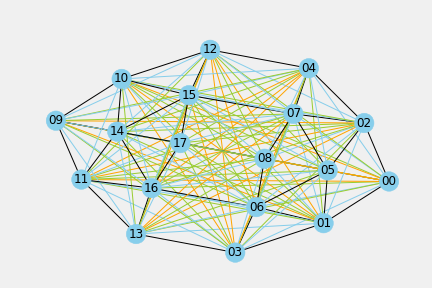
6.2.1. Affordances of 0-length ball-location interactions
Subgraph pl0 is unconnected with 18 isolated nodes.
Table 6.1.a. Network Properties of 0-length ff_pl0 Subgraph
| pli | #nodes | #edges | avdegree | density | center | radius | diameter | periphery |
|---|---|---|---|---|---|---|---|---|
| pl0 | 18 | 18 | 2.0000 | 0.241830 | infinite | infinite | infinite | infinite |
Table 6.1.b All possible 0-length ball-action codes
| sp | fp | 0_nb_ip_fp | sp | fp | 0_nb_ip_fp | sp | fp | 0_nb_ip_fp |
|---|---|---|---|---|---|---|---|---|
| 0 | 0 | 0_0_0000 | 1 | 1 | 0_1_0101 | 2 | 2 | 0_2_0202 |
| 3 | 3 | 0_3_0303 | 4 | 4 | 0_4_0404 | 5 | 5 | 0_5_0505 |
| 6 | 6 | 0_6_0606 | 7 | 7 | 0_7_0707 | 8 | 8 | 0_8_0808 |
| 9 | 9 | 0_9_0909 | 10 | 10 | 0_10_1010 | 11 | 11 | 0_11_1111 |
| 12 | 12 | 0_12_1212 | 13 | 13 | 0_13_1313 | 14 | 14 | 0_14_1414 |
| 15 | 15 | 0_15_1515 | 16 | 16 | 0_16_1616 | 17 | 17 | 0_17_1717 |
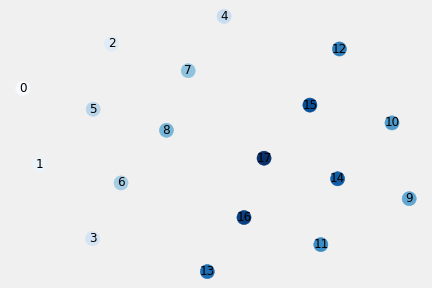
6.2.2. Affordances of 1-length ball-location interactions
Subgraph pl1 is connected with none isolated nodes. The central edge (8, 17), as well (3,13),(6,16),(7,15) and (4,12), is a local bridge of span 3, since the removal of this edge would increase the distance between 8 and 17 to 3. It is possible to think in the existence of obstacles whose effect would be practical as simultaneous removal of two or three central edges that increase the distance between patches in our half landscape and edges in the opponent”s half landscape edges.
Table 6.2.a. Network Properties of 1-length ff_pl1 Subgraph
| pli | #nodes | #edges | avdegree | density | center | radius | diameter | periphery |
|---|---|---|---|---|---|---|---|---|
| pl1 | 18 | 37 | 4.1111 | 0.241830 | [8,17] | 3 | 5 | [0,3,4,9,12,13] |
![Figure 6.3. 1-length ball interactions Centrality Measures of [9..17]-Patches [K Brown]](/images/inaPLpl1_centrality.png)
Table 6.2.b. All possible 1-length ball-action codes
| sp | fp | 1_nb_ip_fp | sp | fp | 1_nb_ip_fp | sp | fp | 1_nb_ip_fp |
|---|---|---|---|---|---|---|---|---|
| 0 | 1 | ‘1_3_0001’ | 0 | 2 | ‘1_7_0002’ | 0 | 5 | ‘1_17_0005’ |
| 0 | 5 | ‘1_17_0005’ | 1 | 3 | ‘1_11_0103’ | 1 | 5 | ‘1_18_0105’ |
| 1 | 6 | ‘1_23_0106’ | 2 | 4 | ‘1_14_0204’ | 2 | 5 | ‘1_19_0205’ |
| 2 | 7 | ‘1_28_0207’ | 3 | 6 | ‘1_24_0306’ | 3 | 13 | ‘1_51_0313’ |
| 4 | 7 | ‘1_29_0407’ | 4 | 12 | ‘1_48_0412’ | 5 | 6 | ‘1_25_0506’ |
| 5 | 7 | ‘1_30_0507’ | 5 | 8 | ‘1_33_0508’ | 6 | 8 | ‘1_34_0608’ |
| 6 | 16 | ‘1_65_0616’ | 7 | 8 | ‘1_35_0708’ | 7 | 15 | ‘1_60_0715’ |
| 8 | 17 | ‘1_70_0817’ | 9 | 10 | ‘1_40_0910’ | 9 | 11 | ‘1_44_0911’ |
| 9 | 14 | ‘1_54_0914’ | 10 | 12 | ‘1_49_1012’ | 10 | 14 | ‘1_55_1014’ |
| 10 | 15 | ‘1_61_1015’ | 11 | 13 | ‘1_52_1113’ | 11 | 14 | ‘1_56_1114’ |
| 11 | 16 | ‘1_66_1116’ | 12 | 15 | ‘1_62_1215’ | 13 | 16 | ‘1_67_1316’ |
| 14 | 15 | ‘1_63_1415’ | 14 | 16 | ‘1_68_1416’ | 14 | 17 | ‘1_71_1417’ |
| 15 | 17 | ‘1_72_1517’ | 16 | 17 | ‘1_73_1617’ |
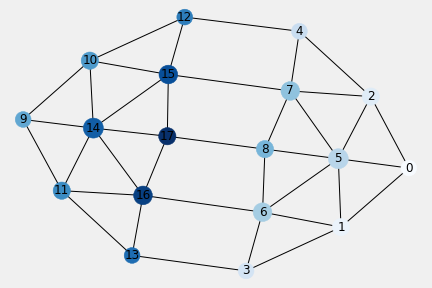
6.2.3. Affordances of 2-length ball-location interactions
Subgraph pl2 is connected with none isolated nodes.
Table 6.3.a. Network Properties of 2-length ff_pl2 Subgraph
| pli | #nodes | #edges | avdegree | density | center | radius | diameter | periphery |
|---|---|---|---|---|---|---|---|---|
| pl2 | 18 | 52 | 5.7778 | 0.339869 | all nodes | 3 | 3 | all nodes |
Table 6.3.b. All possible 2-length ball-action codes
| sp | fp | 2_nb_ip_fp | sp | fp | 2_nb_ip_fp | sp | fp | 2_nb_ip_fp |
|---|---|---|---|---|---|---|---|---|
| 0 | 3 | 2_15_0003 | 0 | 6 | 2_30_0006 | 0 | 4 | 2_20_0004 |
| 0 | 7 | 2_37_0007 | 0 | 8 | 2_44_0008 | 1 | 2 | 2_10_0102 |
| 1 | 13 | 2_72_0113 | 1 | 7 | 2_39_0107 | 1 | 8 | 2_45_0108 |
| 1 | 16 | 2_89_0116 | 2 | 12 | 2_67_0212 | 2 | 6 | 2_32_0206 |
| 2 | 8 | 2_46_0208 | 2 | 15 | 2_82_0215 | 3 | 5 | 2_25_0305 |
| 3 | 8 | 2_47_0308 | 3 | 16 | 2_90_0316 | 3 | 11 | 2_63_0311 |
| 4 | 5 | 2_26_0405 | 4 | 8 | 2_49_0408 | 4 | 15 | 2_83_0415 |
| 4 | 10 | 2_58_0410 | 5 | 16 | 2_91_0516 | 5 | 15 | 2_84_0515 |
| 5 | 17 | 2_96_0517 | 6 | 13 | 2_73_0613 | 6 | 7 | 2_40_0607 |
| 6 | 17 | 2_97_0617 | 6 | 11 | 2_66_0611 | 6 | 14 | 2_80_0614 |
| 7 | 12 | 2_68_0712 | 7 | 17 | 2_98_0717 | 7 | 10 | 2_61_0710 |
| 7 | 14 | 2_79_0714 | 8 | 16 | 2_92_0816 | 8 | 15 | 2_85_0815 |
| 8 | 14 | 2_81_0814 | 9 | 12 | 2_69_0912 | 9 | 15 | 2_86_0915 |
| 9 | 13 | 2_74_0913 | 9 | 16 | 2_93_0916 | 9 | 17 | 2_99_0917 |
| 10 | 11 | 2_62_1011 | 10 | 16 | 2_94_1016 | 10 | 17 | 2_100_1017 |
| 11 | 15 | 2_87_1115 | 11 | 17 | 2_101_1117 | 12 | 14 | 2_77_1214 |
| 12 | 17 | 2_102_1217 | 13 | 14 | 2_78_1314 | 13 | 17 | 2_103_1317 |
| 15 | 16 | 2_95_1516 |
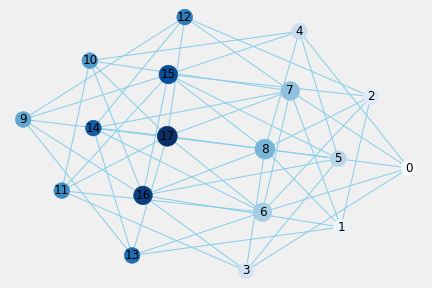
6.2.4. Affordances of 3-length ball-location interactions
Subgraph pl3 is connected with none isolated nodes.
Table 6.4.a. Network Properties of 3-length ff_pl3 Subgraph
| pli | #nodes | #edges | avdegree | density | center | radius | diameter | periphery |
|---|---|---|---|---|---|---|---|---|
| pl3 | 18 | 43 | 4.7778 | 0.281045 | all nodes | 3 | 3 | all nodes |
![Figure 6.6. 3-length ball interactions Centrality Measures of [9..17]-Patches](/images/inaPLpl3_centrality.png)
Table 6.4.b. All possible 3-length ball-action codes
| sp | fp | 3_nb_ip_fp | sp | fp | 3_nb_ip_fp | sp | fp | 3_nb_ip_fp |
|---|---|---|---|---|---|---|---|---|
| 0 | 13 | 3_63_0013 | 0 | 16 | 3_77_0016 | 0 | 12 | 3_58_0012 |
| 0 | 15 | 3_73_0015 | 0 | 17 | 3_81_0017 | 1 | 4 | 3_20_0104 |
| 1 | 11 | 3_54_0111 | 1 | 15 | 3_74_0115 | 1 | 17 | 3_82_0117 |
| 1 | 14 | 3_72_0114 | 2 | 3 | 3_15_0203 | 2 | 10 | 3_49_0210 |
| 2 | 16 | 3_78_0216 | 2 | 17 | 3_83_0217 | 2 | 14 | 3_70_0214 |
| 3 | 7 | 3_34_0307 | 3 | 17 | 3_84_0317 | 3 | 14 | 3_69_0314 |
| 3 | 9 | 3_45_0309 | 4 | 6 | 3_30_0406 | 4 | 17 | 3_85_0417 |
| 4 | 14 | 3_68_0414 | 4 | 9 | 3_43_0409 | 5 | 13 | 3_64_0513 |
| 5 | 12 | 3_59_0512 | 5 | 11 | 3_57_0511 | 5 | 14 | 3_71_0514 |
| 5 | 10 | 3_52_0510 | 6 | 15 | 3_75_0615 | 6 | 9 | 3_46_0609 |
| 6 | 10 | 3_50_0610 | 7 | 16 | 3_79_0716 | 7 | 9 | 3_44_0709 |
| 7 | 11 | 3_55_0711 | 8 | 13 | 3_65_0813 | 8 | 11 | 3_56_0811 |
| 8 | 12 | 3_60_0812 | 8 | 10 | 3_51_0810 | 8 | 9 | 3_47_0809 |
| 10 | 13 | 3_66_1013 | 11 | 12 | 3_61_1112 | 12 | 16 | 3_80_1216 |
| 13 | 15 | 3_76_1315 |
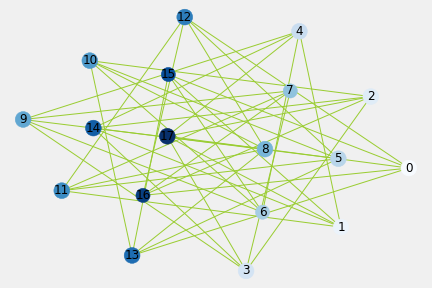
6.2.5. Affordances of 4-length ball-location interactions
Subgraph pl4 is connected with none isolated nodes.
Table 6.5.a. Network Properties of 4-length ff_pl4 Subgraph
| pli | #nodes | #edges | avdegree | density | center | radius | diameter | periphery |
|---|---|---|---|---|---|---|---|---|
| pl4 | 18 | 18 | 2.0000 | 0.117647 | [0,1,2,9,10,11] 4 | 6 | [6,7,15,16] |
Table 6.5.b. All possible 4-length ball-action codes
| sp | fp | 4_nb_ip_fp | sp | fp | 4_nb_ip_fp | sp | fp | 4_nb_ip_fp |
|---|---|---|---|---|---|---|---|---|
| 0 | 11 | 4_25_0011 | 0 | 14 | 4_33_0014 | 0 | 10 | 4_22_0010 |
| 1 | 12 | 4_27_0112 | 1 | 9 | 4_20_0109 | 1 | 10 | 4_23_0110 |
| 2 | 13 | 4_30_0213 | 2 | 9 | 4_18_0209 | 2 | 11 | 4_26_0211 |
| 3 | 4 | 4_12_0304 | 3 | 15 | 4_34_0315 | 3 | 10 | 4_21_0310 |
| 4 | 16 | 4_35_0416 | 4 | 11 | 4_24_0411 | 5 | 9 | 4_19_0509 |
| 6 | 12 | 4_28_0612 | 7 | 13 | 4_31_0713 | 12 | 13 | 4_32_1213 |

6.2.6. Affordances of 5-length ball-location interactions
Subgraph pl5 is low connected with twelve isolated nodes.
Table 6.6.a. Network Properties of 5-length ff_pl5 Subgraph
| pli | #nodes | #edges | avdegree | density | center | radius | diameter | periphery |
|---|---|---|---|---|---|---|---|---|
| pl5 | 18 | 3 | 0.3333 | 0.019607 | 1 |
Table 6.6.b. All possible 5-length ball-action codes
| sp | fp | 1_nb_ip_fp | sp | fp | 5_nb_ip_fp | sp | fp | 5_nb_ip_fp |
|---|---|---|---|---|---|---|---|---|
| 0 | 9 | 5_3_0009 | 3 | 12 | 5_4_0312 | 4 | 13 | 5_5_0413 |
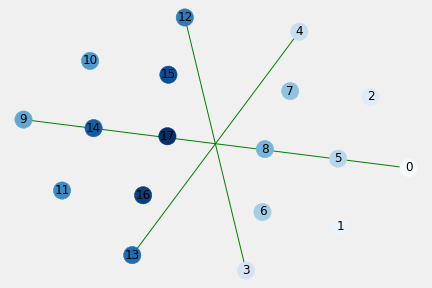
6.3. Global Affordances of APIN Graph of All Possible Football Flow on aPLandscape
Table 6.7.a. Network Properties of i-length APIN Graph and The Largest Component
| pli | #nodes | #edges | avdegree | density | center | radius | diameter | periphery |
|---|---|---|---|---|---|---|---|---|
| APIN | 18 | 171 | 19.0000 | 1.117647 | all nodes | 1 | 1 | all nodes |
The most relevant network property of the entire connected APIN graph is its uniformity. Any patch in the aPLandscape exhibits:
- the same eigenvalue centrality 0.235702
- the same betweenness centrality 0.0
- the same closeness centrality 1.0
- the same eccentricty 1 and,
The APIN graph exhibits a triadic clousure of 1.0 that means each patch in the aPLandscape exhibits the tendency to cluster with any other patch and form triangles in the aPLandscape. Therefore, from any patch we can interact with any other without preferences, but when whe study in detail the set of 1, 2 and 3-length interaction these tendency are constrained by neighborhood. This is a tactical ball-actions of use 0-, 1-, 2- and, 3-length interactions while 4- and 5-length interactions are strategic ball movements for football flow.
There is a phenomenon known as the strength of weak ties, 4-length and 5-length interactions in our aPLandscape, that explain the strategic use of those interactions to superdiffuse the ball flow to the opponent goal’s patch.
Other important phenomenon for football flow fluity is the ‘triad’ concept. If two patches in the aPLandscape -PL graph- have a patch in common - 1-length neighbor-, then there is an increased likelihood that they will interact with themselves at some point in the future. This property con be measured by a local clusteriong coefficient cc.
Table 6.7.b. Triadic Closure Network Property APIN and its i-length pli SubGraphs
| TC-pl0 | TC-pl1 | TC-pl2 | TC-pl3 | TC-pl4 | TC-pl5 | TC-APIN |
|---|---|---|---|---|---|---|
| 0 | 0.387096 | 0.276923 | 0.219512 | 0.0 | 0.0 | 1.0 |